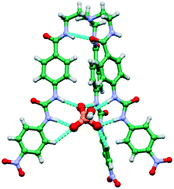Selective encapsulation and extraction of hydrogenphosphate by a hydrogen bond donor tripodal receptor†
Abstract
Selective encapsulation of an anion by a hydrogen bond donor scaffold demands design and synthesis of suitable receptors which could discriminate between anions of identical size and shape or basicity. Here, we report the anion coordination chemistry of two second generation tripodal receptors (AUL and AAL) based on 1H-NMR and crystallization experiments. The tripodal urea-based receptor AUL can selectively encapsulate a hydrogenphosphate (HPO42−) dianion by six strong hydrogen bonds donated from the three urea groups. Theoretical calculations showed that AUL has the highest binding affinity for hydrogenphosphate when compared to other competitive anions (F−, CN−, CH3COO− and HSO4−). Because of its HPO42− selectivity, AUL has been successfully employed in the extraction of HPO42− from water in the presence of competitive anions (F−/OH−/CH3COO−) by anion exchange between two immiscible phases. On the other hand, the tripodal amide-based receptor AAL when crystallized in the presence of F−, CN−, CH3COO−, H2PO4− and HSO4− did not yield any hydrogen-bonded receptor–anion complex and instead crystalline AAL was precipitated in each case. 1H-NMR experiments showed significant broadening and/or downfield shift of –NH signals in AUL and AAL upon additions of F−, Cl−, CN−, CH3COO− and H2PO4− (supplied as tetraalkylammonium salts), indicative of strong hydrogen bonding interactions between –NH donors and anions in the solution-state.

- This article is part of the themed collection: Introducing the CrystEngComm Advisory Board and their research


 Please wait while we load your content...
Please wait while we load your content...